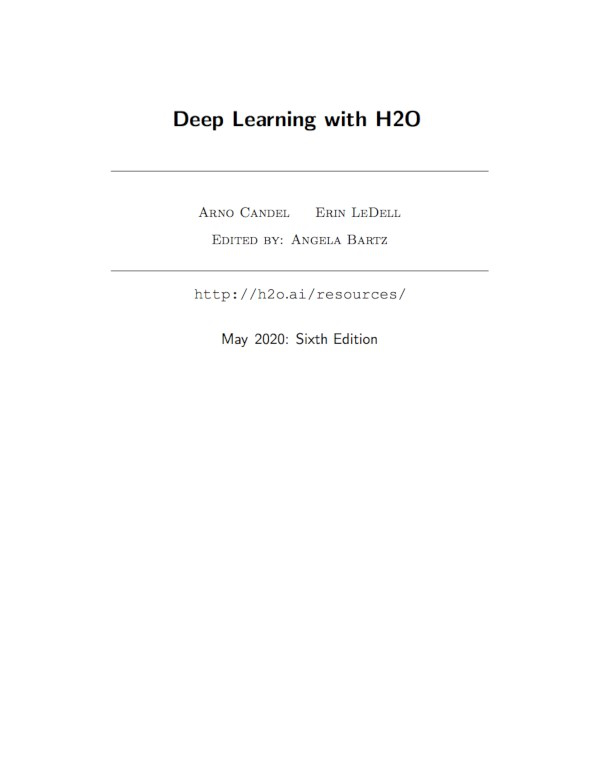Deep Learning with H2O
May 2020: Sixth Edition
Contents
| Section | Title | Page |
|---|---|---|
| 1 | Introduction | 5 |
| 2 | What is H2O? | 5 |
| 3 | Installation | 6 |
| 3.1 | Installation in R | 7 |
| 3.2 | Installation in Python | 7 |
| 3.3 | Pointing to a Different H2O Cluster | 8 |
| 3.4 | Example Code | 8 |
| 3.5 | Citation | 9 |
| 4 | Deep Learning Overview | 9 |
| 5 | H2O’s Deep Learning Architecture | 10 |
| 5.1 | Summary of Features | 11 |
| 5.2 | Training Protocol | 12 |
| 5.2.1 | Initialization | 12 |
| 5.2.2 | Activation and Loss Functions | 12 |
| 5.2.3 | Parallel Distributed Network Training | 15 |
| 5.2.4 | Specifying the Number of Training Samples | 17 |
| 5.3 | Regularization | 18 |
| 5.4 | Advanced Optimization | 18 |
| 5.4.1 | Momentum Training | 19 |
| 5.4.2 | Rate Annealing | 19 |
| 5.4.3 | Adaptive Learning | 20 |
| 5.5 | Loading Data | 20 |
| 5.5.1 | Data Standardization/Normalization | 20 |
| 5.5.2 | Convergence-based Early Stopping | 21 |
| 5.5.3 | Time-based Early Stopping | 21 |
| 5.6 | Additional Parameters | 21 |
| 6 | Use Case: MNIST Digit Classification | 22 |
| 6.1 | MNIST Overview | 22 |
| 6.2 | Performing a Trial Run | 25 |
| 6.2.1 | N-fold Cross-Validation | 27 |
| 6.2.2 | Extracting and Handling the Results | 28 |
| 6.3 | Web Interface | 31 |
| 6.3.1 | Variable Importances | 31 |
| 6.3.2 | Java Model | 33 |
| 6.4 | Grid Search for Model Comparison | 33 |
| 6.4.1 | Cartesian Grid Search | 34 |
| 6.4.2 | Random Grid Search | 35 |
| 6.5 | Checkpoint Models | 37 |
| 6.6 | Achieving World-Record Performance | 41 |
| 6.7 | Computational Performance | 41 |
| 7 | Deep Autoencoders | 42 |
| 7.1 | Nonlinear Dimensionality Reduction | 42 |
| 7.2 | Use Case: Anomaly Detection | 43 |
| 7.2.1 | Stacked Autoencoder | 46 |
| 7.2.2 | Unsupervised Pretraining with Supervised Fine-Tuning | 46 |
| 8 | Parameters | 46 |
| 9 | Common R Commands | 53 |
| 10 | Common Python Commands | 53 |
| 11 | Acknowledgments | 53 |
| 12 | References | 54 |
| 13 | Authors | 55 |
To read the eBook, click the download link above.






